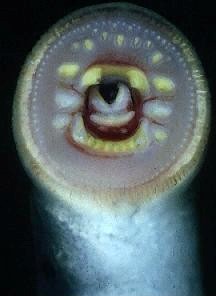Large sea lamprey population | |
| October 29, 2005 By Tom Mitchell Herald Staff  | |
|
MILTON - Biologists have found a hefty new population of sea lampreys in the
Lamoille River, which may be added to the list of Lake Champlain tributaries
to receive chemical treatment. Up to 40,000 lamprey larvae were detected during an electro-shock survey conducted along an 8-mile stretch of the river, officials with the U.S. Fish and Wildlife Service said this week. "We are still trying to determine a strategy in how to deal with it," Brian Chipman, a biologist with Vermont Fish and Wildlife, said recently. The Lamoille River's lamprey larvae population is a bit more than the 30,000-plus larvae previously found in a shallow upper stretch of the Winooski River, which was treated with the lampricide TFM last year, Chipman said. Sea lampreys are eel-like parasites that attach to trout and land-locked Atlantic salmon, wounding and eventually killing them. In the larvae stage, young lampreys live under sediment in streams, according to Wayne Bouffard, a biologist with U.S. Fish and Wildlife Service. The intent is to protect the fish from the predators. The electro-shock drives lampreys out of their burrows, stunning them temporarily as they start swimming. Discovery of a sizable lamprey colony between the mouth of the Lamoille River and the Peterson Dam came as a surprise, Chipman said. "It is indicative of lampreys expanding their range and colonizing new areas," said Bradley Young, a biologist working on the project for U.S. Fish and Wildlife. Project planners would like to treat the Lamoille River with lampricide by next fall but it may take longer to get a permit, he said. Bouffard said planners will need to check on other aquatic species in the river before seeking permits for chemical treatment. They will also need to study water usage in Malletts Bay to determine what sort of advisory should be place, he said. Young added that the cost of treating the Lamoille - about $300,000 - is not yet budgeted. The state will also apply for a permit to treat Lewis Creek in North Ferrisburgh next fall, Chipman said. Permits have already been obtained in New York state for treatments of a number of streams there. It's part of a program on a four-year treatment cycle. No streams are being treated this fall, in a year when few young lamprey were expected in Lake Champlain's tributaries. The Lamoille River, meanwhile, was the only tributary where new lamprey populations were found in 2005, biologists said. In routine surveys, they did not find new populations in Lewis Creek or six streams in New York state. In the spring, Bouffard trapped adult lamprey spawning in a number of smaller rivers. Fishery officials have avoided treating those streams because of the potential for negative impact on native lamprey that also live there. Improved technology that funnels lampreys into a holding cage has resulted in increased numbers of lampreys being taken from streams, Chipman said. "We don't let as many sea lampreys get by as we have in the past," he said. The plan is to continue to use nonchemical methods when possible, he said. Overall trapping counts show that the number of salmon and trout in Lake Champlain wounded by sea lampreys is down because of a steady decline of adult lampreys in the lake, Chipman said. Contact Tom Mitchell at tom.mitchell@rutlandherald.com. | |
| Back to the main page | |